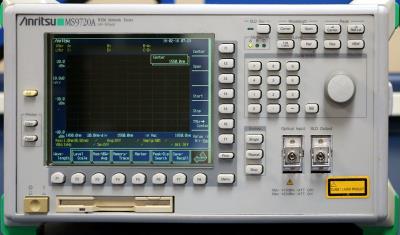
|
|
The Anritsu MS9720A is an optical spectrum analyzer with a diffraction grating that is used to measure and analyze optical spectra in the 1450 to 1650 nm band for WDM communications systems. A wavelength accuracy of ±20 pm is achieved over a range of 1530 to 1570 nm by performing calibration using the built-in wavelength reference light source. The MS9720A noise level is -87 dBm, so the tester is ideal for measuring the SNR of light sources used in WDM systems, as well as optical leakage and reflected light.
Specifications.
Wavelength;
Range: 1450 to 1650 nm.
Accuracy: ±20 pm (1550 ±20 nm, room temperature), ±50 pm (1520 to 1600 nm), ±0.3 nm (all range) *After wavelength calibration.
Stability: ±5 pm (smoothing: 11 pt, 1 minute, at half-width of center wavelength).
Linearity: ±20 pm (1550 ±20 nm).
Read resolution: 5 pm (display resolution: 1 pm).
Setting resolution: 0.1, 0.2, 0.5, 1.0 nm (filter: 3 dB bandwidth).
Resolution accuracy: ≤±10% (1550 ±20 nm, 0° to 30°C), ≤30% (1550 ±100 nm, 0° to 30°C).
Level;
Measurement level ranges:
-87 to +10 dBm (1450 to 1600 nm, 0° to 30°C), -72 to +10 dBm (1600 to 1650 nm, 0° to 30°C),
-82 to +10 dBm (1450 to 1600 nm, 30° to 50°C), -67 to +10 dBm (1600 to 1650 nm, 30° to 50°C),
-68 to +23 dBm (1450 to 1600 nm, 0° to 30°C, internal optical attenuator: on).
Accuracy: ±0.4 dB (1550 nm, -23 dBm).
Stability: ±0.02 dB (1550 nm, -23 dBm, 1 minute, constant temperature, no polarization fluctuation).
Linearity: ±0.05 dB (1550 nm, -50 to 0 dBm).
Flatness: ±0.1 dB (1550 ±20 nm), ±0.3 dB (1520 to 1600 nm).
Polarization dependency: ±0.15 dB.
Dynamic range: 58 dB (at point 1 nm from peak), 53 dB (at point 0.5 nm from peak).
Optical return loss: 35 dB (1550 nm).
SLD output: >-40 dBm/nm (at 1550 nm).
Applicable fiber: 10/125 μm SM fiber (ITU-T G.652).
Optical connector: User replaceable (FC, SC, ST, DIN, HMS-10/A), Factory option (E2000, FC-APC, SC-APC, HRL-10).
Display: 6.4-inch color TFT-LCD.
|